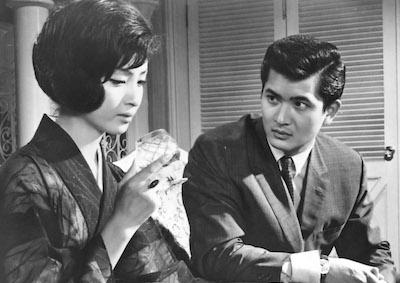Kanto Mushuku
Based on a book by Taiko Hirabayashi, one of Japan’s most famous female novelists, Kanto Wanderer (1963) puts a Suzukian spin on the classic yakuza movie conflict between giri (duty) and ninjo (humanity). Nikkatsu superstar Akira Kobayashi plays Katsuta, a fearsome yakuza bodyguard torn between defending his boss against a rival gang leader and his obsession with Tatsuko, a femme fatale who reappears from his past. Director Seijun Suzuki uses this traditional story to experiment with color and to indulge his interest in Kabuki theater techniques and effects, most notably in the stunning final battle, in which the scenery falls away to reveal a field of pure blood red. “As an example of Suzuki’s mid-period output at Nikkatsu, Kanto Wanderer offers us an inspiring sample of experimentation on assignment.” —Margaret Barton-Fumo, Senses of Cinema.
35mm, color, in Japanese with English subtitles, 92 min. Production: Nikkatsu. Producer: Kenzo Asada. Director Seijun Suzuki. Based on a novel by Taiko Hirabayashi. Screenwriter: Yasutaro Yagi. Cinematographer: Shigeyoshi Mine. Production Design: Takeo Kimura. Editor: Akira Suzuki. Music: Masayoshi Ikeda. With: Akira Kobayashi, Hiroko Ito, Daizaburo Hirata, Chieko Matsubara, Sanae Nakahara.






 Mobile Navigation
Mobile Navigation

